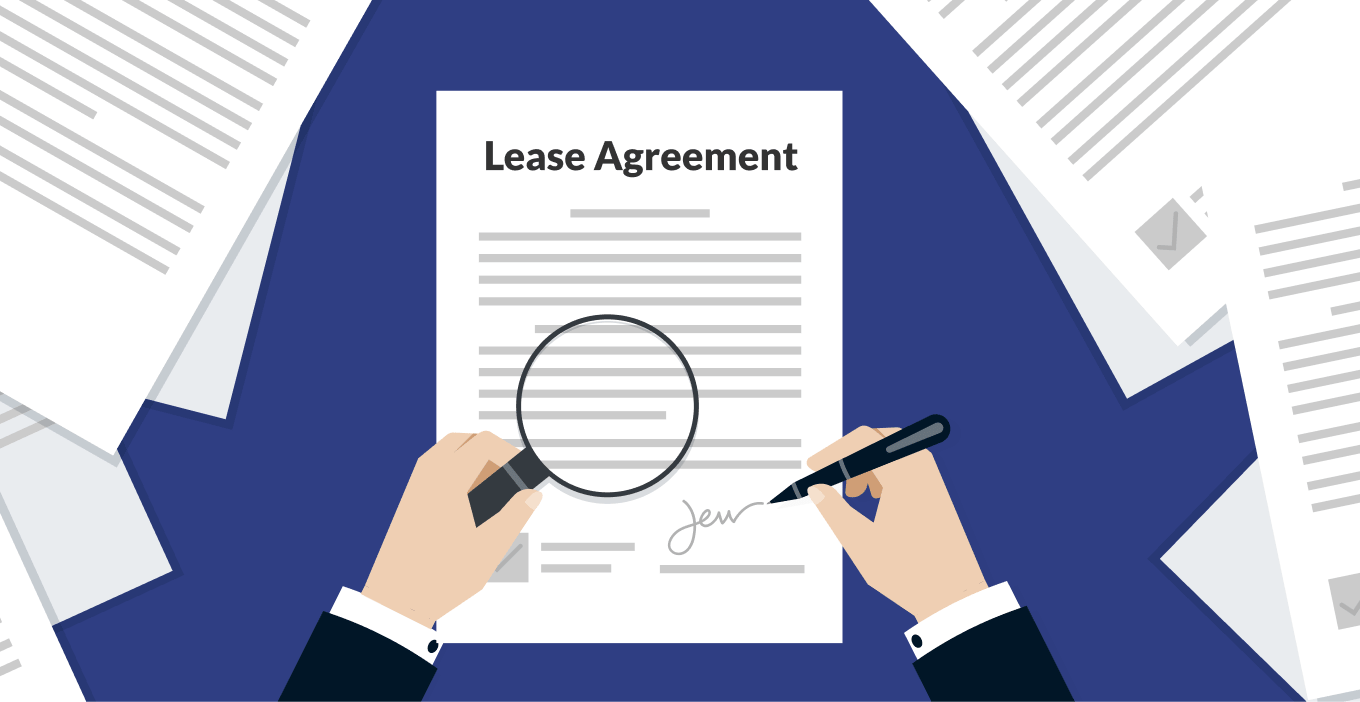Commercial Lease Agreement
E-commerce may be the new fad of this century but having a commercial space where customers can check out your products, build a connection, and develop brand loyalty is still a grave necessity for any business operations. However, the whole debate around leasing personal property vs commercial property often confuses business owners and tenants.
Why don’t we discuss the phenomenal concept of commercial lease agreements so you know what to expect with these legal documents…
Read also – Types of Commercial Leases
What is a commercial lease agreement?
A contract that is drawn between the property owner or landlord and tenant or lessee is called a Commercial Lease Agreement. This legally binding treaty signifies that the occupancy of a piece of commercial real estate is now relinquished to the tenant for a certain period of time for business operations only.
A commercial lease agreement is very different from a residential lease agreement where the leased premises are only allowed to be used for residential purposes. The ordinances of commercial leased properties state that the lessee must not use the commercial space for residential living. The commercial property and its common areas must only be used as office space, warehouse, manufacturing, and other commercial uses alone.
There are different types of commercial lease agreements that contain specific terms about the net lease, usage by square feet or entire blocks, duration of the lease, the process of rent payment, the allowance of storing hazardous materials, and the exclusivity of the tenancy. The governing laws are strict regarding the terms of lease therefore, if you’re a new tenant, you certainly need some legal advice.
Make sure to study the legal documents properly and make note of the waivers, warranties, conditions on tenant defaults, property damage, rent increases in certain intervals, based rent, additional charges, and any penalties on subleases.
Commercial lease agreements are better for businesses rather than purchasing a property because you can move your business at any time by simply terminating the lease agreement and it also costs a lot less in comparison.
Read also – How To Calculate Commercial Rent?
What are the types of commercial lease agreements?
There are six distinct types of commercial lease agreements. Let us take a look at them:
1. Net Lease or N-lease
A net lease states that the tenant pays not only the specified rent amount but also for some or all of the property taxes, maintenance fees, and property insurance.
2. Double Net Lease or NN-lease
The double net lease specifies that the tenant must pay the base rent along with all the property taxes, and property insurance.
3. Triple Net Lease or NNN-lease
The triple net lease or NNN agreement terms of lease specify that the tenant pays the base rent plus any maintenance costs incurred. They must also pay for property insurance and property taxes for the leased premises used by the business entity.
4. Absolute Triple net lease
The Absolute NNN-lease is an all-encompassing agreement wherein the landlord is remitted from any responsibility and the tenant’s business must pay for all the necessities. It includes base rent, property taxes, maintenance costs, and property insurance. The tenant may also be entitled to pay for any property damages and costs incurred to fix or maintain the common areas of the building itself.
Read also – What Is The After Repair Value (ARV)?
5. Gross Lease
A gross lease is also referred to as a fully-serviced commercial lease agreement. These are used for a short duration of leasing wherein the tenant does not have to pay all the additional charges separately. Instead, the rent amount includes an inclusivity clause that comprises the base rent and any other charges that may or may not be incurred under special circumstances.
6. Percentage Lease
A percentage lease is the most beneficial for property owners because it entitles them to a percentage of the profits of the tenant’s business. It means not only does the tenant pay rent for the usage of the leased premises but also shares a pre-determined percentage of the profits earned by the business entity.
What are the important lease terms included in a commercial lease agreement?
A commercial lease agreement includes specific terms of the lease. If a tenant defaults from these terms, the property owner is legally entitled to charge fines or request an immediate vacancy based on how the contract was violated.
Image Credit: chalatilegal.ca
Here are a few important lease terms that you need to keep an eye on when you sign a commercial lease agreement:
1. Duration of the lease
The duration of the lease is predetermined by the landlord and tenant based on the lessee’s needs. Landlords usually prefer long-term leases due to the guaranteed payment, however, new businesses may opt for short-term leases.
A traditional commercial lease agreement tenure can range from 1 year to 100 years for successional business models.
Read also – Comparative Market Analysis (CMA)
2. Base rent and monthly rent
The base rent is a steady rental amount that a lessee can pay for a whole year. However, if the property owner and tenant both agree upon a monthly rent payment instead, then the amount must be specified to two decimal points in the Commercial lease agreement.
The contract must also explain if the rent includes or excludes property taxes, insurance, maintenance, utilities, and additional costs. If the rent is exclusive of these charges then the owner must specify the amount that the tenant needs to pay in regards to these expenses.
The commercial lease agreement must also mention the last date to pay the rent and any additional charges if the tenant defaults on payments.
3. Security deposit
The security deposit is paid by the tenant to the property owner when signing the contract. The commercial lease agreement must specify the amount that was paid in regards to the security deposit and the terms for its repayment.
If the owner intends on deducting charges pertaining to property damage, sudden termination of the lease agreement, modified gross lease charges, and additional charges for maintenance. It must also specify if there are waivers ad warranties involved.
Read also – The Complete Guide To Prepare An Interior Design Contract
4. Rent increases
As a rule of thumb, rent for commercial property leases is escalated by a predefined percentage each year. However, this term can be negotiated between the landlord and tenant for a longer period between escalations.
The commercial lease agreement must specify the percentage increment, the time duration between rent increases, and any waivers for these increments.
5. Details of the commercial property
The commercial lease agreement must specify all the details about the property. The lessor must mention the square footage of the property, the common areas available for use, any parking spaces allocated to the tenant, and most importantly, the exact address of the leased premises.
Read also – Flood Certification on a Property
6. Signage for the leased commercial space
Some lessors are not comfortable with signage on their property. This has to be specified in the commercial lease agreement and if the tenant’s business requires signage then the terms of the lease must be modified.
The lessor can also specify the kind of signage that they permit or prohibit and the size of the sign that the tenant is allowed to put up.
7. Usage of common areas and utility bills
The commercial space will come with a common area around it, which is accessible to all the businesses in that building. Any utility charges and usage of this area must be specified in the agreement.
The property owner could offer to pay for the utility of common areas or specify clearly in the lease that the tenant has to bear all costs. Additionally, using this common area to hang up signs, lay down seating arrangements, etc. also needs to be specified and entered in the commercial lease agreement so both parties are clear on the usage.
Read also – How To Sell Architectural Services?
8. Repairs and improvements to the property
In certain situations, a business entity may need to modify the commercial property to suit its needs. In such cases, the commercial lease agreement must specify whether the lessor or the lessee pays for these modifications and improvements.
It also needs to identify who will be responsible for any repairs. If the tenant is permitted to make changes on their own, they might also be required to revert the commercial space to its original condition before they terminate the lease.
9. The terms of property engagement and usage
If the tenant uses hazardous materials on the commercial property for business purposes, it must be stated clearly in the contract. This is to ensure that there is no residual side-effect on the property itself and no significant consequences for other business tenants in the vicinity.
If there is any property damage that results from the use of unsolicited substances, the lessor is entitled to fine the tenants for involving local governing law figures in the dispute.
Read also – Best Architectural Tools and Software
10. Subleasing the property
On the off chance that a new business doesn’t sustain or a business entity has to move, the tenants are still under contractual obligation with the lessor.
To prevent associated losses, landlords and tenants can come to a mutual agreement when signing the contract that specifies that the commercial tenant can draw sublease agreements with a third party. This entails that the tenant can sublet the leased premises to another business, who will abide by the same terms of the lease as the original contract and pay the monthly rent and additional charges, absolving the original tenant.
11. Exclusivity
An exclusivity clause is important in a commercial space that is vastly allocated to several businesses. It specifies that the lessor is contractually prohibited from leasing out rental units to competitors in the same building. This is particularly helpful for shopping complexes wherein several similar businesses may have the same target demographic.
Read also – 9 Tips To Improve Your Architectural Visualizations
Conclusion
Commercial lease agreements are an absolute necessity for a tenant’s business. The terms of agreement specify a give and take between the landlord and tenant and if either of them deviates from the contract, they are liable to bear the consequences.
Of course, some additional features such as who pays the property taxes, the period of tenancy and occupancy, any conditions for subletting, the base rent and security deposit, and utility bills for common areas are discussed beforehand in the lease terms. However, in its essence, commercial lease agreements simplify the rental process and reduce the charges that the tenant pays as compared to monthly rent.
You can download a commercial lease template and draw up a simple commercial lease agreement with a little legal advice from commercial lawyers can keep an adobe pdf copy handy at all times on your phone or google drive.












Leave A Reply